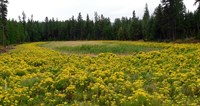
Our nation’s national parks are managed to preserve unimpaired America’s natural and cultural resources. This mission is under a deep and immediate threat as a consequence of invasive animal species.
- Feral swine dig up at-risk plants, damage mound sites, and increase erosion at numerous national parks across the U.S. and in the Pacific Islands.
- Burmese pythons have devastated populations of mammals in Everglades National Park.
- Red imported fire ants pose a threat to sea turtles along the Gulf Coast.
- Aedes mosquitoes bring new diseases that can be transmitted to people, including Zika virus and dengue fever.
- In western states, American bullfrogs prey on and out-compete native frog species, such as the federally threatened California red-legged frog.
Despite these challenges, there are bright spots where parks are managing invasive species challenges, as well as opportunities for the National Park Service to take a lead in addressing the threat.
- Some Hawai’ian parks and Pinnacles National Park in California have used fencing to successfully exclude feral swine and other invasive ungulates from sensitive areas.
- Hawai’ian parks set up a rigorous inspection program that prevented the introduction of little fire ants into their parks, thus avoiding a fate similar to those parks along the Gulf Coast.
- Yosemite National Park has eradicated American bullfrogs from their waters, helping re-establish the natural ecosystem that previously existed there.
Successfully maintaining America's treasures - the national parks - requires coordinated and innovative action to manage invasive animal species.
Invasive Animals in Parks
- Death Valley National Park
Eleven burros found dead near Owls Hole Spring in Death Valley National Park
- Point Reyes National Seashore
Release of Record of Decision on the Non-Native Deer Management Plan for Point Reyes National Seashore
- Type: Park
- Locations: Point Reyes National Seashore
The Record of Decision for the Point Reyes National Seashore (PRNS) Non-Native Deer Management Plan: Protecting the Seashore’s Native Ecosystems, Final Environmental Impact Statement was published in the Federal Register on November 29, 2006.
- Type: Lesson Plan
- Locations: Everglades National Park,Shenandoah National Park,Sleeping Bear Dunes National Lakeshore
- Type: Article
- Locations: Anacostia Park,Baltimore-Washington Parkway,Chesapeake & Ohio Canal National Historical Park,Fort Dupont Park,Fort Foote Park, more »
- Acadia National Park
Importance of Invasive Fishes on Aquatic Food Webs
- Acadia National Park
Asian shore crab discovered by a middle school citizen scientist in Acadia National Park
- Type: Article
- Locations: Acadia National Park
A middle school-aged citizen scientist made a grim, yet significant discovery in an intertidal area near the edge of Little Moose Island near Winter Harbor, Maine. It is believed to be among the first confirmed reports of an invasive Asian shore crab (Hemigrapsus sanguineus) within Acadia National Park.
- Puʻuhonua o Hōnaunau National Historical Park
Successful Live Goat Removal Operation Yields 458 Goats
- Type: Park
- Locations: Puʻuhonua o Hōnaunau National Historical Park
- Yellowstone National Park
Lake trout–induced spatial variation in the benthic invertebrates of Yellowstone Lake
- Point Reyes National Seashore
The Natural Laboratory Podcast: Park Science Day
- Type: Audio
- Locations: Point Reyes National Seashore
A The Natural Laboratory podcast produced by the Pacific Coast Science and Learning Center in 2009 in which John Cannon interviews Marcus Koenen, the San Francisco Bay Area Network's Inventory and Monitoring Coordinator, and two other participants the first San Francisco Bay Area Park Science Day.
- Hopewell Culture National Historical Park
Emerald Ash Borer at Hopewell Culture National Historical Park
- Type: Article
- Locations: Hopewell Culture National Historical Park
Last updated: May 12, 2021








